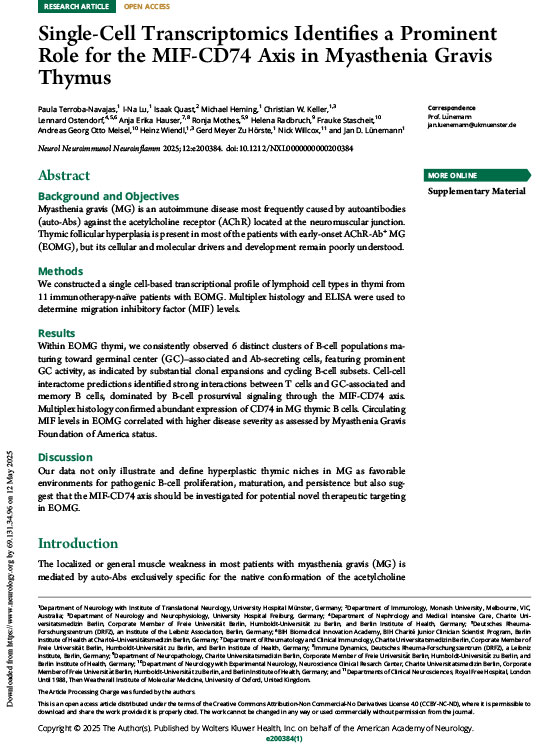Single-Cell Transcriptomics Identifies a Prominent Role for the MIF-CD74 Axis in Myasthenia Gravis Thymus
Mar-25
Abstract
Background and Objectives
Myasthenia gravis (MG) is an autoimmune disease most frequently caused by autoantibodies (auto-Abs) against the acetylcholine receptor (AChR) located at the neuromuscular junction. Thymic follicular hyperplasia is present in most of the patients with early-onset AChR-Ab+ MG (EOMG), but its cellular and molecular drivers and development remain poorly understood.
Methods
We constructed a single cell-based transcriptional profile of lymphoid cell types in thymi from 11 immunotherapy-naïve patients with EOMG. Multiplex histology and ELISA were used to determine migration inhibitory factor (MIF) levels.
Results
Within EOMG thymi, we consistently observed 6 distinct clusters of B-cell populations maturing toward germinal center (GC)–associated and Ab-secreting cells, featuring prominent GC activity, as indicated by substantial clonal expansions and cycling B-cell subsets. Cell-cell interactome predictions identified strong interactions between T cells and GC-associated and memory B cells, dominated by B-cell prosurvival signaling through the MIF-CD74 axis. Multiplex histology confirmed abundant expression of CD74 in MG thymic B cells. Circulating MIF levels in EOMG correlated with higher disease severity as assessed by Myasthenia Gravis Foundation of America status.
Discussion
Our data not only illustrate and define hyperplastic thymic niches in MG as favorable environments for pathogenic B-cell proliferation, maturation, and persistence but also suggest that the MIF-CD74 axis should be investigated for potential novel therapeutic targeting in EOMG.

